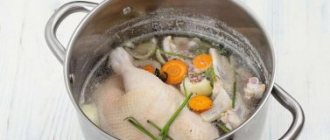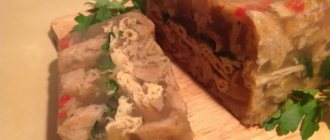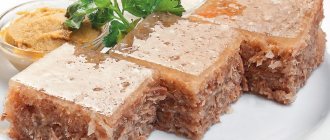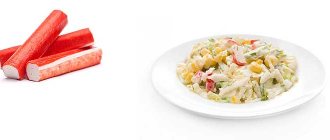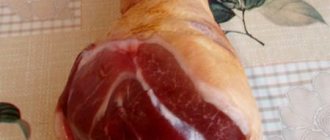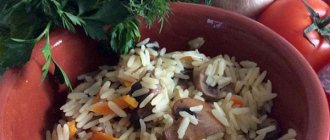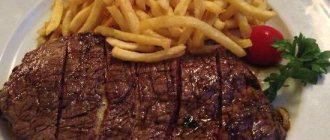History of the dish
How did this dish come about?
When the meat broth cooled, it turned into a jelly-like mass. This was considered a flaw, so it was heated to make it liquid again. And the French decided to take advantage of this and prepared a new dish. They cooked veal, game, pork, rabbit together and twisted everything together. Then they added spices and eggs, added a little broth so that the mass was like thick sour cream. Then they put it in the cold and called it galantine, that is, jelly.
Then the recipe came from France to Russia. Where there was already a similar recipe - jelly.
True, they prepared it a little differently. Everything that was left after a feast in rich houses was chopped, boiled and taken out into the cold. But he looked completely unattractive, so he was given to the servants. When a new French recipe arrived, Russian chefs improved their jelly, and it became a noble aspic. And ordinary people began to cook jellied meat more often, because the ingredients for it were cheaper than for aspic.
Types of food
Jellied meat is pieces of meat that are filled with broth. The liquid cools and hardens to a jelly-like mass. Most often, they use legs, tails, lips, ears, heads - that is, offal.
It can be prepared from one type of meat (veal, pork, poultry, beef) or from several (assorted).
What to cook depends on the taste and preference of those who will consume this food.
Benefits and harms
Of course, the most important component is gelatin, which is necessary for shock absorption and joint mobility. It is not for nothing that this product is recommended for use after fractures.
And another useful substance is collagen. This dish contains large amounts of collagen. Collagen is a protein that is essential for our body. Protein prevents tissue from deteriorating and slows down the aging process of the body. All this, of course, is useful for people with problems in the musculoskeletal system.
The presence of B vitamins in the dish normalizes the functioning of the nervous system and also promotes the formation of hemoglobin. Therefore, it is useful to eat it to prevent anemia. Aminoacetic acid or glycine has a good effect on brain function and relieves depression.
As you can see, the benefits of jellied meat are quite great, but excessive consumption can also have harmful effects on the body. The main problem is cholesterol, which is present in the dish. It promotes the formation of plaques in blood vessels, which leads to heart attack and stroke.
In addition, do not forget about the calorie content of jellied meat - frequent consumption can bring extra pounds.
How to reduce calories?
The calorie content of this dish is not so easy to determine. After all, it depends on the ingredients of the dish. For example, the calorie content of pork jellied meat will be 180 kcal per 100 grams. However, this dish can have an energy value of up to 350 kcal if fatty meat is used. Naturally, such a dish will be very high in calories and unhealthy for those who want to lose weight.
And the calorie content of chicken jellied meat is 120 kcal. Since the most delicious food is considered to be old chicken, which has little fat, the number of calories will not greatly affect body weight. Yes, and chicken is considered the most tender and dietary, so for those losing weight, chicken jellied meat is allowed. The most dietary one is made from chicken legs. You just need to eat it infrequently.
How many calories are in beef jellied meat and can those who are losing weight eat it? There are only 80 calories in 100 g of beef jellied meat. Of course, it can be consumed if you are losing weight. It turns out that this is the most dietary option.
To reduce calories, simply increase the amount of water in the broth or use less meat. The calorie content of beef jellied meat will be lower if you also use tongue, which is a dietary product, and when preparing pork, add vegetables (carrots, celery).
So, the calorie content of jellied meat per 100 g varies quite a lot, it can vary from 80 to 350 kcal. Since we have already found out that you can prepare dietary food, we offer you several delicious recipes.
Assorted
Since the calorie content of jellied meat made from pork legs is very high, we will use meat with low calorie content.
Take veal and beef shanks, chicken and turkey wings - all these are dietary products. Pour water over the meat and when it boils, add carrots, garlic, onions and salt. Cook for about 4 hours, use beef as a guide as it takes longer to cook than other meats. Then add allspice, bay leaf, maybe a little more garlic and leave for five minutes. After this, remove the meat and vegetables from the broth, strain the latter. Disassemble or cut the meat into pieces, place in bowls and fill with broth. When it hardens, you can eat it.
Chicken
Here it is better to use wings and breast.
Required:
- chicken meat – 800 g;
- onion – 70 g;
- carrots – 100 g;
- gelatin – 30 g;
- parsley, garlic, bay leaf, salt, peppercorns.
How to do:
- fill the chicken with water, add the onion in the peel, pepper, bay leaf;
- when it boils, add whole carrots and salt. After 15 minutes, remove the carrots and cut into rings;
- cook for another hour and a half, and remove the meat and vegetables;
- pour gelatin into a glass of cold water and leave for half an hour;
- disassemble the chicken and place in a container, top with carrots and garlic;
- mix the broth with gelatin, heat and pour over the chicken and vegetables;
- chop the parsley and sprinkle on top;
- refrigerate 10 hours.
Beef
Cover the beef completely with water and cook uncovered for six hours. Skim off foam regularly if it appears. While cooking, peel the carrots and onions and add to the pan an hour before the end. Place the spices there and add salt. When everything is ready, place the meat in a mold, garnish with carrots, sprinkle with garlic, and pour in broth. Cool in the refrigerator. If any fat appears, remove it before serving.
The benefits of jellied meat
Many national cuisines contain analogues of our jelly. Why is strong meat and bone broth so popular all over the world?
Since during long-term cooking all the substances of cartilage, bones and connective tissues of meat and offal pass into the broth, this broth becomes a storehouse of protein - collagen. As we all know, collagen fills our skin tissues, responsible for the elasticity and youthfulness of our skin.
Also, regular consumption of gelatinous dishes prevents inflammation and joint diseases (arthritis and arthrosis), because During long-term heat treatment, gelling substances are produced that restore joint mobility and strengthen bones and connective tissues.
One of the substances is lysine, which ensures the body’s absorption of calcium and also, together with retinol, strengthens the immune system.
Jelly is also a source of B vitamins for the body, which are involved in hematopoiesis, improve hemoglobin and demonstrate high antioxidant properties.
What is important is that polyunsaturated fatty acids and glycine (aminoacetic acid) in the decoction have a positive effect on the functioning of the brain and the entire nervous system. This is reflected in improved memory, concentration and increased mental performance.
In general, jelly should be included not only in the menu for the holiday table. Kholodchik can also be included in the Sunday menu, because preventing diseases of the musculoskeletal system will not hurt anyone, right?
The calorie content of jellied meat can be adjusted using additional ingredients. We include more vegetables, improve the taste with spices and seasonings, choose beef or poultry instead of pork.
The health hazards of this dish are also obvious! Thick bone broth is cholesterol almost in its pure form, so it is not recommended to overuse jelly. Cholesterol will be deposited on the walls of blood vessels as cholesterol plaques, and this will lead to their narrowing. You understand that this can lead to cardiovascular diseases and their extreme manifestations - strokes and heart attacks.
Also, eating an excessive amount of jelly can lead to a slowdown in metabolism, a noticeable burden on the liver, and ultimately lead to illness and weight gain.
In conclusion, I would like to say that jellied meat and jelly do not differ in the basic cooking technology and are one and the same dish. But in ordinary culinary usage, jellied meat is considered to be a lighter and less calorie dish made from poultry or young beef (veal). The calorie content of jelly is higher, since it is a stronger and thicker broth of pork and pork by-products (ears, legs, etc.).
It's hard to find a person who doesn't love you at all. If not the classic pork or beef, with horseradish and mustard, then almost everyone likes the light chicken one. It is worth noting that the energy value of such a dish greatly depends on the recipe and the ingredients in the composition, so those who are watching their weight should be careful when choosing this dish.
How many calories are in pork jellied meat?
Pork jellied meat contains the maximum amount of easily digestible collagen, which improves hair, skin and nails, and most importantly, allows you to maintain healthy joints for many years. However, this same version of the dish is also the most high-calorie: depending on the recipe, it can contain from 320 to 390 kcal for every 100 g of product. This is not the best option for those trying to lose weight.
It is worth noting that the calories in jellied pork are greatly increased due to the dense layer of fat that is deposited on the surface. If it is peeled off rather than eaten, the energy value of the product will be reduced.
How many calories are in beef jellied meat?
Beef jellied meat turns out lighter, since the meat itself contains much less fat. It is thanks to this difference that beef jellied meat is a more preferable dish for those watching their figure. There is less collagen in such jellied meat, but also fewer calories.
Depending on the recipe, 100 g of such jellied meat contains from 140 to 190 kcal for every 100 g of product. Add a little more water and herbs and roots to it - and the product will turn out even lighter.
By the way, jellied meat can be reduced by 30-50 units if you add chicken breast, which is famous for its lightness and lack of fat. In this case, the energy value of the product will be lower, and it will be safer for the figure.
22.06.17
Jellied meat is a frequent guest at any feast. Considering that this dish is quite high in calories, many doubt whether they can afford it and how often? To understand this, consider the classic recipe and calorie content of the product.
Ingredient Selection
To prepare a very tasty and healthy jellied meat, you should carefully select the main ingredients.
- The pork must be fresh, not stale; to buy it, it is best to go to the market. There is no way for the imported goods to be treated with chemical compounds that hide the old appearance of the meat products.
- The same goes for pork hooves and knuckles. Their shade should be light, without any dark spots. There should be no mucus present to the touch.
- Before buying, you should not only look at the selected piece of meat, but also smell it. A fresh product should have a pleasant, even sweetish aroma.
- If the meat was purchased frozen, it must be transferred to a large container, filled with water and left overnight. By morning the meat will melt, then you can start cooking with it.
- It is better to purchase chicken for jellied meat from familiar farmers. Homemade products are famous for the fact that when raising poultry and livestock, no chemical additives are used to enhance growth and increase carcass size.
What are the benefits of chicken jellied meat?
A product made from chicken or turkey meat is most useful for those who want to lose weight. The calorie content of jelly is very low, and it contains a lot of valuable substances. These are the main vitamins C, A, B, elements: iron and magnesium, calcium.
Choline in chicken or turkey jellied meat helps regulate metabolism and has a beneficial effect on the nervous system. The collagen present in the product has a good effect on hair and skin. This is also why the benefits of jellied chicken feet will be especially great for the fair sex.
Chicken feet. Benefits and harms for joints
This product contains substances that can restore cartilage tissue, especially in older people:
- Collagen and mucopolysaccharides - these elements are necessary for the formation of connective tissues of the musculoskeletal system. In addition, collagen maintains skin elasticity, preventing the appearance of wrinkles.
- Eating chicken feet is good for joints, as they contain calcium and cartilage tissue, thanks to which articular cartilage is formed, joints become stronger and more mobile.
- Proteins form muscle tissue. They are especially useful as a supplement to training and stimulate muscle growth.
The most delicious and healthy dish made from chicken feet is undoubtedly jellied meat, which contains the maximum amount of the listed substances. However, despite the undoubted benefits, it is not worth preparing dishes from them often. After all, these by-products have a fairly high fat content, which is harmful for people who are prone to obesity. Therefore, it is enough for them to consume such products once a week.
Its calorie content will be 180 kcal per 100 grams of product
But we can often see a rather thick layer of fat appear on the surface of the jellied meat. Therefore, pork jellied meat can have different calorie content (sometimes up to 350 kcal). Therefore, for those who adhere to a diet or during fasting days, pork jellied meat is, of course, not recommended.
Jellied meat made from chicken is much lower in calories. Its energy value is approximately 120 kcal per 100 g. product. Considering that the best chicken jellied meat is made from “old” chicken, which has relatively little fat, its reasonable consumption will not significantly affect body weight. In addition, this type of jellied meat is very tender and, like any chicken dish, can well be called a dietary product.
But for people who are prescribed an extremely strict diet, beef jellied meat is best suited, the calorie content of which is only 80 kcal per 100 grams. product.
What is the calorie content of jellied meat prepared in different ways? And here it is:
Table of caloric content of jellied meat, per 100 grams of product:
| Product | Calories, in kcal |
| beef | 80,0 |
| pork | 334,0 |
| chicken | 120,0 |
| turkey | 52,0 |
| pork feet | 200,0 |
And the nutritional value of jellied meat prepared in different ways is as follows:
Table of nutritional value of jellied meat (BJU), per 100 grams of product:
| Product | Calories, in kcal |
| beef | 140,0 |
| pork | 334,0 |
| chicken | 100,0 |
| turkey | 52,0 |
| pork feet | 200,0 |
How to prepare this dish at home? Here is one of the recipes:
Chicken jellied meat:
Products:
- Chicken breasts - 2-3 pieces - depending on size
- Boiled potatoes - 1 piece
- Boiled egg - 4 pieces
- Parsley - 1 bunch
- Garlic - 5 cloves (to taste)
- Gelatin (with seasonings) - 700 g. broth
Boil potatoes and eggs. The eggs are cut into 4 pieces each, and the potatoes into cubes. Boil the chicken, chop it finely (you can even just split it with your hands). Parsley is cut. They lay out the products. Gelatin is diluted in chicken broth and cooked, stirring, over low heat for about 10-15 minutes (according to the instructions). At the end, add finely chopped garlic to the broth. Pour broth over cooked foods. Then the dish is placed in the cold to harden. That's all! Eat for your health, only in moderation, since the calorie content of jellied meat, even from chicken, is quite high.
Amazing recipe for jellied meat in a slow cooker
This dish can be prepared not only traditionally, but also using a kitchen appliance that has become very popular - a multicooker.
Products:
- Large chicken feet - 5 pcs.;
- If desired, necks and heads - 2-3 pieces each;
- Chicken legs - 3 pcs.;
- Garlic - 5 cloves;
- 1 large carrot;
- Bay leaf - 3 leaves;
- Black peppercorns - 6-8 pcs;
- Salt.
Before cooking, chicken legs should be processed in exactly the same way as in the traditional recipe: soak for 3 hours in cold water, wash and scrape thoroughly, removing films and dirt.
If it is decided to add heads and necks to the paws, then they must first be tarred on an open fire from a gas burner or using fire from special flammable tablets, etc. funds, then wash thoroughly.
Place the prepared chicken parts in a slow cooker and pour 1.5 liters of water into the bowl so that it only slightly covers the meat. Add salt and pepper to taste and set the timer in the multicooker for 5 hours on the “Stew” mode.
In the meantime, the carrots need to be peeled and placed in a bowl for cooking no earlier than 3 hours from the start of stewing the chicken.
Article on the topic: “Attack” phase of the Dukan diet: menu for 7 days with recipes
When the jellied chicken legs are ready, you need to remove all the chicken parts from the broth, separate the meat from the skin and bones, chop finely or separate into fibers.
Arrange the meat evenly among the jelly molds, then remove the carrots from the multicooker, cut them into circles, shape them into shapes if desired (for example, stars), carefully place the carrots on top of the meat.
Carefully pour the broth on top, which must first be strained. Add peeled and finely chopped garlic cloves to each form with jellied meat.
Let it cool first at room temperature, and then in the refrigerator for 6 - 8 hours until the dish has completely hardened. You can also serve jellied chicken paws with herbs, mustard, horseradish, halves of boiled eggs, and pickled vegetables.
How to calculate the number of calories in this dish?
The calorie content of the finished dish depends on the following factors:
- selected recipe;
- proportions of inclusion of ingredients;
- other features.
It is very important to pay attention to caloric content and energy value for those who are overweight or have any problems that require dieting.
Pork, chicken and beef have completely different energy values. To calculate the number of calories of a dish , add up the indicators of all its ingredients. This may include:
- meat;
- cartilage;
- bones;
- fats;
- spices and other ingredients.
Depending on the type, quality of meat and accompanying ingredients, the calorie content of jellied meat per 100 grams can vary significantly. Below we will look at the approximate number of calories in jellied meat depending on the type of meat used.
Jellied pork feet
Pork legs are an offal that you cannot do without when preparing jellied meat. They contain the necessary gelling substances. Therefore, they are added to the jelly regardless of what kind of meat is used.
.
In its raw form, there are 215 kcal per 100 grams of pork legs.
As a result of cooking, the calorie content of dishes decreases, this is due to the addition of water.
To compensate for the high calorie content of pork legs, you can add lean beef or chicken to the dish. In this case, a 100-gram portion can contain from 150 kcal.
Cooking recipes
Today in the culinary world there are many options for preparing Russian jelly. But the most common is the classic recipe for jellied pork and chicken. The cooking process is very long, but to a greater extent you only have to observe rather than take an active part. Before you start creating a chicken and pork masterpiece, you should prepare the necessary products:
- pork leg – 1 pc.;
- pork knuckle – 1 pc.;
- ham – 1 pc.;
- carrots – 2 pcs.;
- onion – 6 pcs.;
- black peppercorns – 1 tsp. l.;
- water – 3 l.;
- garlic – 3 cloves;
- bay leaf - pair;
- salt - to taste.
Having collected the entire list of required products, you can start cooking.
- First you need to thoroughly rinse the meat. Then place the assorted meats in a container and fill with water. Set aside for 3 hours. During this period of time, the remaining blood will be drawn out of each piece.
- The used water is drained and the meat is washed again. Chicken pieces should be checked for feathers and hairs. If any are present, the meat should be seared at home on a stove with an open flame.
- After these manipulations, all the meat pieces are placed in a deep pan, filled with clean water and placed on the stove.
- Boiled liquid must be replaced with fresh one. Put it back on the stove. This must be done to get rid of excess fat.
As soon as the second boiling of the broth has begun, you should use a slotted spoon. All foam must be removed from the surface of the water. These are the final residues of blood that can add bitterness to the taste of the finished dish.
- While the meat is simmering, you need to prepare the vegetables, peel them and rinse them thoroughly. You can cut vegetables into strips, semicircles and even cubes, depending on the desire of the cook. But most often, vegetables cut into rings are dipped into jellied meat.
- Then all the ingredients are lowered into the broth simmering over low heat. First vegetables, then bay leaf, pepper and salt. To obtain an extraordinary taste, salt is added in the amount of 1 teaspoon per 6 liters of water.
Jellied meat for treating joints. Chicken feet recipes
Traditionally, jellied meat was a decoration for the festive table for us. Now we know that its consumption helps improve the condition of not only joints, but also hair and nails. This hearty and tasty dish also improves your appetite. Jellied meat is quite simple to prepare:
- The chicken's feet must be cleaned of the upper keratinized layer, and the claws must also be cut off. In order for the shell to be easily removed, the washed paws must first be kept in boiling water for one minute and then immediately lowered into ice water.
- Rinse them with water several times.
- Fill the paws with plenty of water.
- You need to cook the jellied meat over low heat. The cartilage should be completely separated from the bones. This is approximately 6-8 hours.
- Half an hour before it is ready, add spices.
- When the broth is ready, you need to strain it and pour it into small containers and put a few legs in each. If you don’t want bones in the jellied meat, you can separate the cartilage and skin from the legs and just put them in the jellied meat.
- Place the jellied meat to harden in the refrigerator or other cool place.
At what age can jellied meat be given to children?
Classic jelly is too “heavy” food for a child’s body. But the beneficial properties of the product are still important for growing babies. Therefore, children from 6 or 7 months of age are recommended to be offered a special homemade baby jellied meat - made from chicken meat, without salt and other seasonings and spices. The benefit of chicken aspic will be that the product will strengthen the child’s immunity and promote the development of bones and muscles.
You should start complementary feeding using an amount of no more than a quarter of a teaspoon. If there is no negative reaction, then gradually, by the time the child is one year old, the amount of jelly can be increased to 50 g per day.
Important! Since even low-fat and unsalted jellied meat can harm a child, it can be introduced into the diet only after consultation with a pediatrician.
Useful properties of the product
We have already mentioned that jellied meat has a large number of beneficial properties. For example, it contains collagen - a valuable protein that, when cooked, is boiled from meat by-products . It is very beneficial for the skin, thanks to it, it becomes elastic, folds and wrinkles disappear. And eating the dish on a regular basis is good for the prevention of bone and joint diseases.
This product also contains components that help strengthen the immune system and absorb calcium. It also contains vitamins C, as well as the amino acid glycine, which stimulates nervous and brain activity. The dish contains many components that the body needs daily.
Composition, beneficial properties and harm of jellied meat
In order to prepare delicious jellied meat, you just need to buy meat, bones and other meat products, where preference is given to those parts of the carcass that contain a large amount of natural gelatin and connective tissue. Depending on the type of meat, the calorie content of the product changes, while the composition of jellied meat remains practically unchanged, and it has a number of useful properties. Strong meat broth, which is the basis of jellied meat, contains all the beneficial substances transferred from meat, cartilage and bones. Collagen deserves special attention, as it participates in the normalization of the musculoskeletal system and fills the skin tissue, making the skin elastic.
Jellied meat is recommended for consumption by people with diseased joints, on which it has a beneficial effect, preventing the occurrence of arthritis and arthrosis. When cooking jellied meat, a jelly-like substance is formed that restores joint mobility. Before talking about how many calories are in pork jellied meat, for example, it is worth studying the beneficial properties of the meat itself, based on which we can talk about how healthy such jellied meat will be. Most often, jellied meat contains polyunsaturated fatty acids and glycine, which improves brain function. The B vitamins contained in jellied meat also deserve attention, as they are involved in hematopoietic processes. The only harm of jellied meat is that it often contains a large amount of calories, but this, again, depends on the type of meat.
To understand what calorie content jellied meat has, and to understand how many calories are in jellied beef, chicken or pork, you need to know the calorie content of meat and if you do not want to get problems in the form of extra pounds, it is better to use lean meats. The most dietary is beef jellied meat, the “weight” of which is less than 100 kcal. You can also prepare chicken jellied meat, after asking how many calories are in chicken jellied meat. Jellied chicken feet are considered less nutritious (120 kcal), and the “weight” of jellied chicken thighs reaches 280 calories.
Most often, several types of meat are used to prepare jellied meat. Chicken and pork go well together, so we offer information on how many calories are in jellied pork and chicken, and this depends on what part is used, but we can definitely say that it is at least 200 kcal per 100 grams of product. Given the lower calorie content of beef, we can guess how many calories are in jellied pork and beef. On average, the minimum “weight” of this dish is 150 kcal. Since the fat content of beef and lean chicken do not differ much, it is not difficult to answer the question of how many calories are in jellied chicken and beef.
Jellied meat has a good taste, for the preparation of which turkey meat is used, in addition to chicken. It is not difficult to answer the question of how many calories are in jellied chicken and turkey, knowing that the average calorie content of jellied turkey itself is approximately 150 kcal. If you really care about your health and don’t want to have extra pounds, you should pay attention to how many calories are in jellied pork feet. This is the most high-calorie jellied meat, the “weight” of which reaches 350 calories, and it is absolutely not suitable for dietary nutrition. In any case, the main thing is to exercise restraint and not overuse, including aspic.
How did this dish come about?
When the meat broth cooled, it turned into a jelly-like mass. This was considered a flaw, so it was heated to make it liquid again. And the French decided to take advantage of this and prepared a new dish. They cooked veal, game, pork, rabbit together and twisted everything together. Then they added spices and eggs, added a little broth so that the mass was like thick sour cream. Then they put it in the cold and called it galantine, that is, jelly.
Then the recipe came from France to Russia. Where there was already a similar recipe - jelly.
True, they prepared it a little differently. Everything that was left after a feast in rich houses was chopped, boiled and taken out into the cold. But he looked completely unattractive, so he was given to the servants. When a new French recipe arrived, Russian chefs improved their jelly, and it became a noble aspic. And ordinary people began to cook jellied meat more often, because the ingredients for it were cheaper than for aspic.
Types of food
Jellied meat is pieces of meat that are filled with broth. The liquid cools and hardens to a jelly-like mass. Most often, they use legs, tails, lips, ears, heads - that is, offal.
It can be prepared from one type of meat (veal, pork, poultry, beef) or from several (assorted).
What to cook depends on the taste and preference of those who will consume this food.
Benefits and harms
Of course, the most important component is gelatin, which is necessary for shock absorption and joint mobility. It is not for nothing that this product is recommended for use after fractures.
And another useful substance is collagen. This dish contains large amounts of collagen. Collagen is a protein that is essential for our body. Protein prevents tissue from deteriorating and slows down the aging process of the body. All this, of course, is useful for people with problems in the musculoskeletal system.
The presence of B vitamins in the dish normalizes the functioning of the nervous system and also promotes the formation of hemoglobin. Therefore, it is useful to eat it to prevent anemia. Aminoacetic acid or glycine has a good effect on brain function and relieves depression.
As you can see, the benefits of jellied meat are quite great, but excessive consumption can also have harmful effects on the body. The main problem is cholesterol, which is present in the dish. It promotes the formation of plaques in blood vessels, which leads to heart attack and stroke.
In addition, do not forget about the calorie content of jellied meat - frequent consumption can bring extra pounds.
How to reduce calories?
The calorie content of this dish is not so easy to determine. After all, it depends on the ingredients of the dish. For example, the calorie content of pork jellied meat will be 180 kcal per 100 grams. However, this dish can have an energy value of up to 350 kcal if fatty meat is used. Naturally, such a dish will be very high in calories and unhealthy for those who want to lose weight.
And the calorie content of chicken jellied meat is 120 kcal. Since the most delicious food is considered to be old chicken, which has little fat, the number of calories will not greatly affect body weight. Yes, and chicken is considered the most tender and dietary, so for those losing weight, chicken jellied meat is allowed. The most dietary one is made from chicken legs. You just need to eat it infrequently.
How many calories are in beef jellied meat and can those who are losing weight eat it? There are only 80 calories in 100 g of beef jellied meat. Of course, it can be consumed if you are losing weight. It turns out that this is the most dietary option.
To reduce calories, simply increase the amount of water in the broth or use less meat. The calorie content of beef jellied meat will be lower if you also use tongue, which is a dietary product, and when preparing pork, add vegetables (carrots, celery).
So, the calorie content of jellied meat per 100 g varies quite a lot, it can vary from 80 to 350 kcal. Since we have already found out that you can prepare dietary food, we offer you several delicious recipes.
Assorted
Since the calorie content of jellied meat made from pork legs is very high, we will use meat with low calorie content.
Take veal and beef shanks, chicken and turkey wings - all these are dietary products. Pour water over the meat and when it boils, add carrots, garlic, onions and salt. Cook for about 4 hours, use beef as a guide as it takes longer to cook than other meats. Then add allspice, bay leaf, maybe a little more garlic and leave for five minutes. After this, remove the meat and vegetables from the broth, strain the latter. Disassemble or cut the meat into pieces, place in bowls and fill with broth. When it hardens, you can eat it.
Chicken
Here it is better to use wings and breast.
Required:
- chicken meat – 800 g;
- onion – 70 g;
- carrots – 100 g;
- gelatin – 30 g;
- parsley, garlic, bay leaf, salt, peppercorns.
How to do:
- fill the chicken with water, add the onion in the peel, pepper, bay leaf;
- when it boils, add whole carrots and salt. After 15 minutes, remove the carrots and cut into rings;
- cook for another hour and a half, and remove the meat and vegetables;
- pour gelatin into a glass of cold water and leave for half an hour;
- disassemble the chicken and place in a container, top with carrots and garlic;
- mix the broth with gelatin, heat and pour over the chicken and vegetables;
- chop the parsley and sprinkle on top;
- refrigerate 10 hours.
Beef
Cover the beef completely with water and cook uncovered for six hours. Skim off foam regularly if it appears. While cooking, peel the carrots and onions and add to the pan an hour before the end. Place the spices there and add salt. When everything is ready, place the meat in a mold, garnish with carrots, sprinkle with garlic, and pour in broth. Cool in the refrigerator. If any fat appears, remove it before serving.
Who is it suitable for and for what occasions?
Anyone can use it; there are no specific contraindications. It is especially useful for people with disorders of the musculoskeletal system. However, you should remember that you need to use the right products for cooking - chicken, beef. But you shouldn’t eat pork jellied meat often – it has too many calories. This applies more to those who are losing weight. How many pieces can you eat? Try not to overdo it - 2-3 slices will be enough. Children can also eat this dish, but little by little and infrequently.
You can serve it for holidays or as an everyday meal. If you are going to serve food on a holiday table, decorate the dish. For this purpose, you can use onions, carrots, eggs, herbs, canned corn or peas, peppers, mushrooms, and berries. Cut out flowers or geometric shapes, arrange vegetables beautifully.
Serving options: in a large dish, cut into pieces, in small molds, in shelled eggs. Glasses, disposable cups, baking tins, and cocotte makers are also suitable.
So, if you are going to cook this dish, choose dietary meat, use more vegetables. Then extra pounds won't threaten you.
Each housewife has her own secrets for preparing various meat dishes and tries to make them healthy and safe for the figure. In order for consumption to be safe for your figure, you need to at least know approximately how many calories are in the jelly.
Jellied meat, beloved by many, varies greatly in calorie content depending on the preparation recipe, so the amount of nutrients depends on the ingredients.
Depending on the meat and offal used, a strong meat broth may have different nutritional value and may or may not affect the figure.
It goes without saying that fatty meat, offal or bones increase the calorie content of jellied meat. If you use chicken meat with offal, then this decoction will be lighter. One way or another, the main ingredients answer the question of how many calories are in jellied meat.
We have tabulated the calorie content of all types of jelly so that you can estimate the calorie content of the dish, depending on the ingredients of the recipe:
The benefits of beef jellied meat
Jelly made from beef is less fatty than pork and is much better digestible, by as much as 76%. Therefore, you can use the product even with many gastrointestinal diseases; it will not cause harm.
Beef jelly contains a large amount of vitamin A, so it is extremely beneficial for eye health. The product contains carotene, which strengthens muscle, bone and connective tissues and promotes their recovery. The benefits of jellied beef legs will be especially great for athletes whose muscles and joints are subject to special stress.
How many calories are in beef jellied meat?
Here's how much:
Prepare jellied meat according to this recipe:
Products:
- beef shank with bone - one and a half kilograms. — (2070 kcal)
- onions – 2 pieces. — (90 kcal)
- beef ribs - kilogram. — (2170 kcal)
- carrots - 2 pieces. — (64 kcal)
- allspice – 12 pieces.
- bay leaves - a couple of pieces.
- fresh garlic cloves – 10 pieces. — (43 kcal)
- black pepper, peas - 10 pieces.
- salt - one teaspoon.
We wash the meat, take a pan in which we put the meat and fill it with cold water so that the meat is completely covered with water. Place on the stove and turn up the heat so that the water in the pan boils quickly. Then reduce the heat to such an extent that the broth practically does not boil. Don’t forget to skim the foam from the broth until it stops appearing. Do not cover the pan and cook the meat for 6 hours. We peel the onions and carrots, and an hour before the broth is cooked, throw in the onions, carrots, pepper, bay leaf and salt.
Place the cooked meat on a large plate and separate it from the bones. Place the separated meat into the jellied meat mold, and spread chopped garlic on top of it in an even layer. Strain the broth and pour it over the meat in the mold. We wait until the broth cools down and put the form with jellied meat in the refrigerator until it hardens completely.
Based on the posted recipe:
The calorie content of beef jellied meat, per 100 grams, is:
Proteins, fats and carbohydrates (BJU) in gr. per 100 grams:
Proteins - 17.0
Fats – 8.3
Carbohydrates – 1.5
Can jellied meat be used by pregnant and lactating women?
During the period of bearing a child, jelly can bring both benefit and harm. The main danger is that the product can increase cholesterol levels in the blood and cause excess weight gain.
However, the product also has benefits for pregnant women. Jellied meat improves hemoglobin production, helps absorb calcium, removes toxins and strengthens the immune system. Therefore, you can still take the product during pregnancy - just in small quantities, and after consulting a doctor.
Chemical composition of jellied meat
Many people like the taste of jellied meat, but they value the product primarily for its beneficial properties. Namely, it contains:
- useful minerals - copper, potassium, phosphorus;
- elements fluorine, sulfur, rubidium;
- aluminum and boron, calcium and vanadium;
- polyunsaturated fatty acids;
- collagen and glycine;
- gelatin;
- retinol;
- valuable aliphatic amino acid;
- vitamins - C, B9, A.
Even a small portion of high-quality jelly brings great benefits to the body.
How to cook jellied meat at home
You don’t have to buy classic jelly in a store—you can make the delicacy yourself at home. Since the benefits of jellied beef are the greatest, and the harm is minimal, it is recommended to cook it. You will need to take the following products:
- cleaned beef leg, or fetlock joint - 1.3 kg;
- beef of the highest category - 800 g;
- chicken breast - 1.8 kg;
- water - 3 l;
- carrots - 300 g;
- onions - 350 g;
- a little garlic - about 40 g;
- parsley root - 250 g.
Jellied meat in a slow cooker:
Cooking jellied meat in a slow cooker is very simple, profitable and convenient. You can load all the necessary ingredients into the multicooker in the evening and turn on the “Simmering” mode at night, or set the jellied meat to cook in the morning and go to work. Cooking such a dish in a slow cooker cannot be compared with cooking jellied meat on the stove: you don’t need to constantly run around and check whether the broth has escaped, you don’t need to skim off the foam and monitor the cooking temperature.
- Leg (pork) – 2 pcs.
- Meat (you can have chicken, beef, pork, or all together - to your taste!) - 0.5 kg
- Water - 2.5 l
- Onion - 1 pc.
- Salt
- Black pepper (peas) – 5 pcs.
- Garlic - 5 teeth.
Jellied meat for treating joints
Among the beneficial properties of the product, one valuable quality is especially noted - a positive effect on joints and connective tissues. The fact is that any jelly, especially beef, contains a high percentage of animal protein. It is protein that is largely responsible for the rapid restoration of tendons, cartilage, ligaments and bones.
Regular consumption of beef or pork jelly is highly recommended for athletes. During training, their joints are subjected to particularly heavy loads and are often injured. The protein, collagen and carotene in the product can protect bone tissue from destruction, and in addition, will further increase physical endurance.
Pork jellied meat
This dish is the most high-calorie, since pigs are raised not only for meat, but also for lard. The calorie content of such jellied meat can be from 190 to 330 kcal per 10 grams , it all depends on the fat content of the meat you use. But in any case, pork jellied meat cannot be used as a dietary dish.
As already mentioned, calorie content depends not only on the type of meat, but also on its part, here’s how it can differ:
- pork jellied meat – 200 kcal per 100 grams;
- beef – 80 kcal;
- chicken – 200 kcal;
- chicken paws – 120 kcal;
- from chicken paws and thighs – 280 kcal;
- chicken jellied meat in a slow cooker – 100 kcal;
- turkey – 150 kcal;
- from pork legs – 350 kcal.
What are the benefits of jellied chicken feet?
According to Japanese scientists, broth made from chicken feet helps lower blood pressure, since the feet contain the most protein, which helps normalize pressure in the arteries.
And the bones of the paws contain, as mentioned above, the maximum percentage of collagen, which contributes to the elasticity of human ligaments, joints and skin. And the older we get, the more relevant this is, so this dish should certainly be present in the diet of older people.
In addition to collagen and protein, chicken feet and their processed products contain choline and a whole complex of vitamins C, E, A, K, PP, B vitamins, as well as important minerals: iron, magnesium that helps fight stress, calcium for bones, zinc for skin health, natural antioxidant selenium, performance-enhancing potassium, as well as copper, sulfur, phosphorus, sodium and manganese.
With such tangible benefits and low cost of the product, it is also suitable for those trying to lose weight: the calorie content of chicken feet of this product is only 215 kcal.
How to cook healthy, tasty and beautiful jellied chicken legs
| Ingredients | Quantity |
| Chicken feet - | 700 g |
| Chicken fillet or drumsticks - | 600 g |
| Onion - | medium sized head |
| Medium sized carrots - | 1 PC. |
| Garlic - | about 4 cloves or to taste |
| Peppercorns - | 10 pieces. |
| Lavrushka - | 3 leaves |
| Salt - | 1 tbsp. l. or to taste |
| Parsley - | 1 bunch |
| Cooking time: 420 minutes | Calorie content per 100 grams: 220 Kcal |
Place the chicken legs in cold water and leave them in it for 3 hours so that you can easily scrape off all the dirt from them. After washing, remove the films from the clean paws and place them in a deep container of at least 3 liters.
Coarsely chop the washed and peeled carrots into several pieces. Wash the onion, cut off the dried top and bottom without completely peeling it, place the vegetables, fillets or drumsticks in a pan with the prepared legs, pour in 3 liters of cold water and cook for about 2 or even 3 hours.
Article on the topic: How to quickly and deliciously bake a layer cake with cheese
An important point when cooking is not to miss when the water boils. To avoid clouding of the broth and maintain its transparency (which is necessary for the beautiful appearance of jellied meat), all foam and scale that forms when the broth boils must be carefully and thoroughly removed.
After 2-3 hours, remove the pan from the stove and strain the broth. The onion, which gave the broth its aroma and golden hue during the cooking process, should be discarded, and the carrots can be set aside to decorate the dish.
The paws themselves are also not useful, and the rest of the boiled meat needs to be taken out, separated into fibers and put back into the broth.
Season the chicken broth with spices and simmer over low heat for at least another half hour or forty minutes, then remove from heat and check how the jellied meat has thickened.
This is done like this: cool a teaspoon of broth so as not to burn yourself, and check with your fingers - the consistency of the broth should become viscous, resembling a paste. If, however, the jellied meat has not frozen properly, this can be corrected with the help of gelatin, which must be boiled together with the broth.
Then cut the peeled garlic into pieces, chop the parsley coarsely, add them to the broth and cover with a lid, allowing to stand for a short time. Pour the finished broth into suitable forms and cool.
Garnish, if desired, with the remaining boiled carrots cut into stars or circles, halves or slices of boiled eggs (quail eggs can be used) and fresh herbs. Place in the refrigerator.
Jellied chicken legs should be served with horseradish and mustard; you can also serve it with pickled vegetables. Before serving, additionally (optional) decorate the surface of the dish with mayonnaise.
The benefits of pork jellied meat
The beneficial properties of a product made from pork knuckle, tail, ears or legs are dictated by the valuable qualities of the pork itself. In particular, it contains amino acids and iron, vitamin B12 and myoglobin, animal fat.
Pork jellied meat:
- effectively protects the body from vitamin deficiency;
- replenishes calcium reserves;
- has a beneficial effect on the condition of blood vessels and the heart.
Attention! The benefit of jellied pork legs for men is that the properties of the product serve as a prevention of prostatitis and improve potency.
What are the health benefits of jellied meat?
Meat jelly is not only nutritious, it has a pleasant taste and is beneficial for the body. Specific valuable properties depend on what meat the dish is prepared from. But there are several common qualities inherent in any jelly. Namely, the product has a positive effect:
- for immunity - retinol present in the dish successfully fights viruses and infections;
- on joints - gelatin in the product strengthens bone and connective tissue;
- on the nervous system - glycine in the jelly improves brain function and helps get rid of depression;
- on metabolic processes - in particular, the product’s properties are very effective for hangover syndrome.
Features of the composition
Collagen also helps stop the development of autoimmune diseases. Numerous studies involving patients with arthritis, arthrosis and other joint diseases have shown that when eating dishes made from chicken feet, there is a decrease in swelling and other manifestations of disease. Some patients experienced remission altogether.
Chicken feet also contain hyaluronic acid , which activates anti-aging processes, that is, the joints are restored and retain their mobility and elasticity for a significant amount of time.
How many calories are in a chicken dish?
The calorie content here will depend on what kind of chicken meat is used. The lowest calorie is jellied chicken paws; its energy value is only 120 kcal per 100 grams .
There is no fat in this part of the meat, so it is considered dietary in itself. And if whole chicken is used to prepare jellied meat, the calorie content of the finished product will exceed 200 kcal per 100 grams. You don’t have to worry about extra pounds if you eat chicken jellied meat within reasonable limits. Sources
- https://PohudeemSami.ru/kalorijnost-xolodca
- https://eda-land.ru/svinina/prigotovlenie/holodec-iz-nog/
- https://poleznii-site.ru/pitanie/myaso-i-ryba/holodets-polza-i-vred-dlya-organizma-prigotovlenie-otzyvy.html
- https://prokalorijnost.ru/xolodec-kalorijnost-polza-i-dieticheskie-svojstva
- https://dietolog.guru/produkty-i-pohudenie/kalorazh-gotovyh-blyud/kaloriynost-holodca-iz-raznyh-vidov-myasa-na-100-gramm.html
Paw broth
If jellied chicken feet is a fairly complex dish, you can prepare regular broth to treat joints, which will not harden.
To do this, you need to prepare the paws, place them in a pan and simply add water. After two hours, the broth is ready for use.
It is recommended to pour it into a plate. The product must be taken as a medicine - 100 ml daily. The course of treatment is 14 days. The taste of the broth without spices and salt leaves much to be desired, but the benefits for the joints are beyond doubt.
